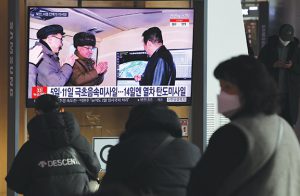Bloomberg
North Korea test-launched two suspected ballistic missiles on Monday in its fourth rocket volley this year, turning up pressure on the Biden administration with its biggest string of tests since August 2019.
South Korea’s military said North Korea fired what appeared to be two ballistic missiles into waters off its east coast at 8:50 and 8:54 am that flew about 380 kilometers (240 miles), reaching an altitude of 42 km. Japan estimated the two suspected ballistic missiles flew about 300 km and landed in waters outside its exclusive economic zone. North Korea typically doesn’t comment on its launches until a day after the fact.
The tests underscore North Korea’s ability to strike U.S. allies South Korea and Japan, and the new technologies put fresh pressure on all three nations. They could be a way to force the Biden administration to come up with a new strategy towards North Korean leader Kim Jong-un, according to Rand Corp analyst Soo Kim.
“Kim Jung-un may be trying to figure out, ‘At what point will the US start to tip?’ And with each successive, successful test, Kim probably perceives that he’s getting closer to this tipping point,†said Soo Kim, who previously worked at the Central Intelligence Agency.
The Biden administration has repeatedly called for Kim to get back to the negotiating table and indicated the US could return to a policy of providing economic rewards in return for disarmament steps. The US is also looking to ratchet up pressure through sanctions, which have drawn bitter rebukes from North Korea in the past.
The tests come after the North Korean leader told a top-level meeting of his ruling party at the end of 2021 that he was more interested in bolstering his arsenal than returning to nuclear disarmament talks with the US, which have been stalled for nearly three years.
While Kim has stayed away from such talks, he has been steadily increasing his nuclear arsenal, testing new systems for quick strikes and those that can maneuver in flight to avoid US-operated interceptors in the region. These have included long-range cruise missiles that could hit almost all of Japan and a new submarine-launched ballistic missile.
North Korea has also resumed plutonium-producing operations at its main Yongbyon nuclear site, while satellite imagery shows it expanding a plant that enriches uranium for weapons. It has also lashed out at South Korea for testing new missile and systems, accusing Seoul and Washington of double standards.
‘Legitimate Right’
This month, Kim’s regime has had two separate launches of a hypersonic missile systems designed to use high speeds and maneuverability to evade US-operated interceptors. Pyongyang said it fired two tactical guided missiles from rail carriages Friday.
Before that launch, North Korea warned it would take a “stronger and certain reaction†after the U.S. sanctioned individuals associated with Pyongyang’s weapons program, saying tests this month of its hypersonic missile system were part of its “legitimate right†to enhance its self-defense.
“Pyongyang appears to be laying the groundwork for talks on nuclear disarmament on the Korean Peninsula, rather than talks on North Korea’s denuclearization, for when it decides to return to the talks,†said Rachel Minyoung Lee, a nonresident fellow with the 38 North Program at the Stimson Center.
She said there may be escalated tensions after South Korea’s presidential elections in March, and if there are any changes in the policy positions from Seoul and Washington.
 The Gulf Time Newspaper One of the finest business newspapers in the UAE brought to you by our professional writers and editors.
The Gulf Time Newspaper One of the finest business newspapers in the UAE brought to you by our professional writers and editors.
